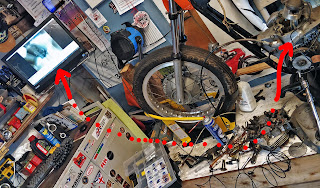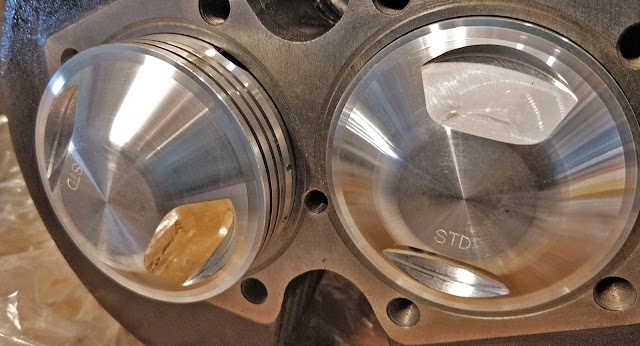I’ve got a degree in English, but working on the old Bonneville is stressing out even my vocabulary:
 |
| That’d be your gudgeon pin right there. |
Gudgeon: one who will bite at any bait or swallow anything, credulous or gullible person Mer. V. I. i. 102. (that might apply to this project)
Definition of gudgeon pin: WRIST PIN
Definition of wrist pin: a stud or pin that forms a journal (as in a crosshead) for a connecting rod (that’s it!)
Gudgeon pins? After the massive fight that was removing the seized cylinder head, I was bracing for misery, but I was able to pop the circlips (!) out and tap the gudgeon pins (!) through with no sweating and swearing. Pink Floyd was playing on the computer and I think music from its era calms the old Bonneville down when I’m working on it.

I had a close look at the connecting rods and they appear to be in good shape and the bottom end of the motor moves freely. I think next steps are to remove the rest of the engine from the frame, give the oil-in-frame a deep clean and then recoat it with some quality paint. With the frame cleaned up and sorted I’ll strip the rest of the motor and clean everything out to ensure nothing’s whacky before I begin the great rebuild.

The gudgeon pin itself looks to be in good shape, which is good because the head kit didn’t come with new ones. The circlips came out nicely too but the kit did come with those. It amazes me that even specialized material like that in these cylinders can withstand the extreme forces they operate in. This Bonnie had done at least twenty thousand miles on these cylinders and they’re still in remarkable shape considering they were face to face with more than 17 controlled explosions every second (a spark plug typically fires about 17 times per second at 2000rpm!). You’d think all that heat and violence would cause more wear than I’m seeing in the beating heart of this motor.

This is the 3/8 inch socket extension I used to tap the gudgeon pins out. Nothing grabbed or slowed the process down and I barely had to apply any pressure. I might have even been able to push them out had I been so inclined. I caught the pin as it came loose and the cylinder lifted off the connecting rods easily. Again, considering the extreme conditions the heart of every engine operates under, I’m impressed by the engineering and metallurgy that makes all this possible.

Here’s the whole kit from British Cycle Supply. It includes the cylinder head, cylinders, piston rings, circlips for the gudgeon pins and a head gasket. I swiped the last one they had in stock for $688.75CAD ($535USD – told you I got a good deal). Unfortunately I might be the last person on the planet to get a 750cc kit that cheap. Prices will be going up on the new stock and probably even higher than that as we’re in an inflationary spiral thanks to Putin overreaching and years of pandemic fueled broken supply chains; we live in interesting times.

Another tool came in that’s interesting. I was reading Practical Sportsbikes last week (highly recommended if you love bikes and getting your hands dirty on them), and editor Chris mentioned an endoscope smartphone camera he was using on a project bike to inspect the internal parts of an engine. I found one on Amazon for under $40CAD and it came in on the weekend. It lets you see parts of the engine that haven’t seen light before. It’s an exciting thing that offers you a look into the secret life of engines. I’m looking forward to using it as i continue to work on the Bonnie.
 |
| That look on my face after the first ride in a long, long time. |
 |
| The 12 year old Kawasaki (left) and the 19 year old (!) Tiger (right) were keen to turn a wheel after a long hibernation. |
 |
| Bison were out bisoning at Black Power Bison Co. when I was out for a ride in balmy 6°C March Sunday. |
from Blogger https://ift.tt/uDmtY9N
via IFTTT







